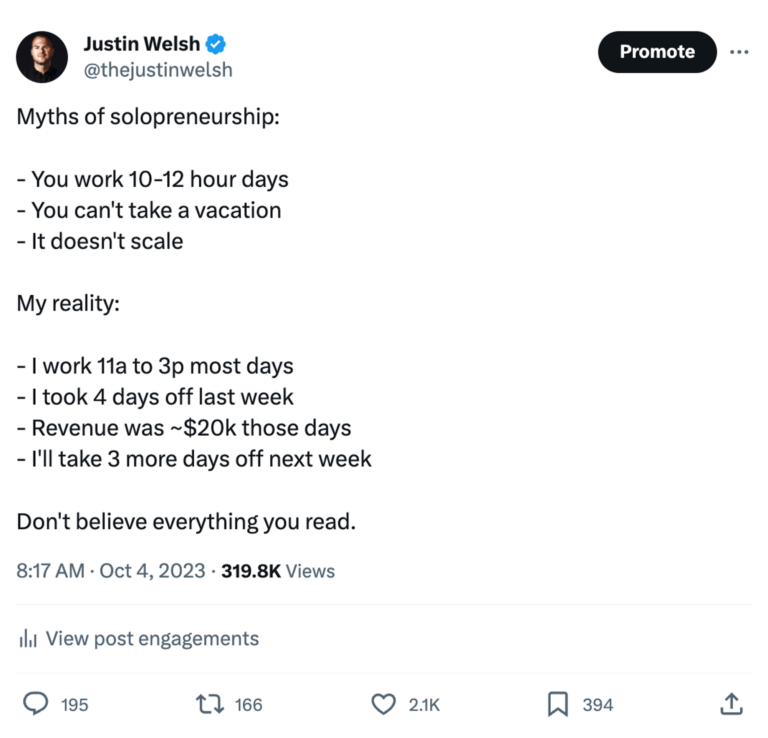Contrast and Compare Tweet Template
Use this Tweet template to challenge a common myth in your industry and present your reality in a different light
Why this Tweet Template works
This Tweet performed really well for a reason:
1. It addresses some of the most common myths about solopreneurship and then contrasts them with a better reality. People love to compare and contrast content.
2. It uses concrete examples and specific details (working hours, vacation days, revenue), which makes the post more credible (and engaging).
The Blank Tweet Template
Myths of [Topic or Profession]:
- [Common Belief #1]
- [Common Belief #2]
- [Common Belief #3]
My reality:
- [Your Reality #1]
- [Your Reality #2, including a specific metric or example]
- [Your Reality #3, including a specific metric or example]
- [Additional Point if needed]
Don’t believe everything you read about [Topic or Profession].
How to use this Twitter Tweet Template
To utilize the “Contrast & Compare” Tweet content template effectively, follow these detailed steps across five key areas:
1. Evaluate the Template’s Fit for Your Content Goals and Needs
Identify Your Objective: Determine whether your goal is to educate, debunk stereotypes, establish authority in your niche, or engage with your audience on a more personal level. This template is excellent for addressing misconceptions, which is particularly useful in industries riddled with myths or misunderstanding.
Relevance: Assess how the myths and realities you plan to share align with your broader content strategy. For instance, if you’re in the fitness industry, debunking myths about diets or workouts can position you as a knowledgeable and trustworthy source.
2. Audience Awareness within the Buyer’s Journey
Understand the Buyer’s Journey Stage: Identify which stage your target audience is in—awareness, consideration, or decision. This template works best with audiences in the awareness stage, where educating and myth-busting can effectively guide them to the next stage.
Tailor Content to Audience Needs: Ensure the myths and realities you choose to debunk or affirm resonate with your audience’s current perceptions and challenges. If your audience is already well-informed about the basics, deeper, niche-specific myths can be more engaging.
3. Personalization
Reflect Personal or Brand Experience: Share myths and realities based on your unique experiences or data. Personal stories or case studies make your content relatable and credible. For instance, if you’re addressing common misconceptions about sustainable living, sharing how certain practices have personally reduced your carbon footprint can be powerful.
Incorporate Audience Insights: Leverage any data or feedback you have on your audience’s beliefs and questions. Tailoring content to directly address these points increases engagement and relevance.
4. Modern Trends
Leverage Current Events: Incorporate recent studies, news, or trends that can debunk myths or confirm realities in your industry. This keeps your content timely and demonstrates your commitment to staying informed.
Use Engaging Formats: Consider integrating multimedia elements like infographics or short videos that align with current content consumption trends. For example, a split-screen video comparing myth versus reality can be very engaging on platforms like Instagram or TikTok.
5. Call to Action (CTA)
Encourage Interaction: Ask your audience to share their experiences or myths. This will not only increase engagement but also provide insight into their perceptions and misconceptions.
Guide to the Next Step: Depending on your objectives, your CTA could invite your audience to learn more by linking to a blog post, signing up for a webinar, or following you for more myth-busting content. Make sure it’s clear, actionable, and directly related to the content you’ve shared.
By thoughtfully applying these steps to the “Contrast vs. Compare” template, you can create compelling content that educates, engages, and establishes your authority.


